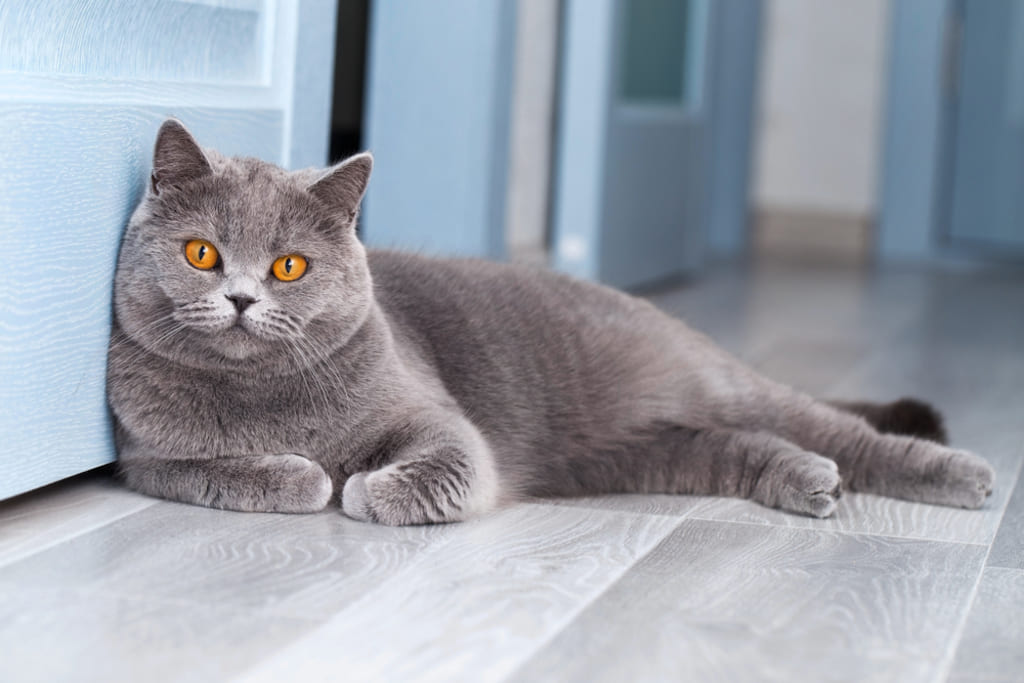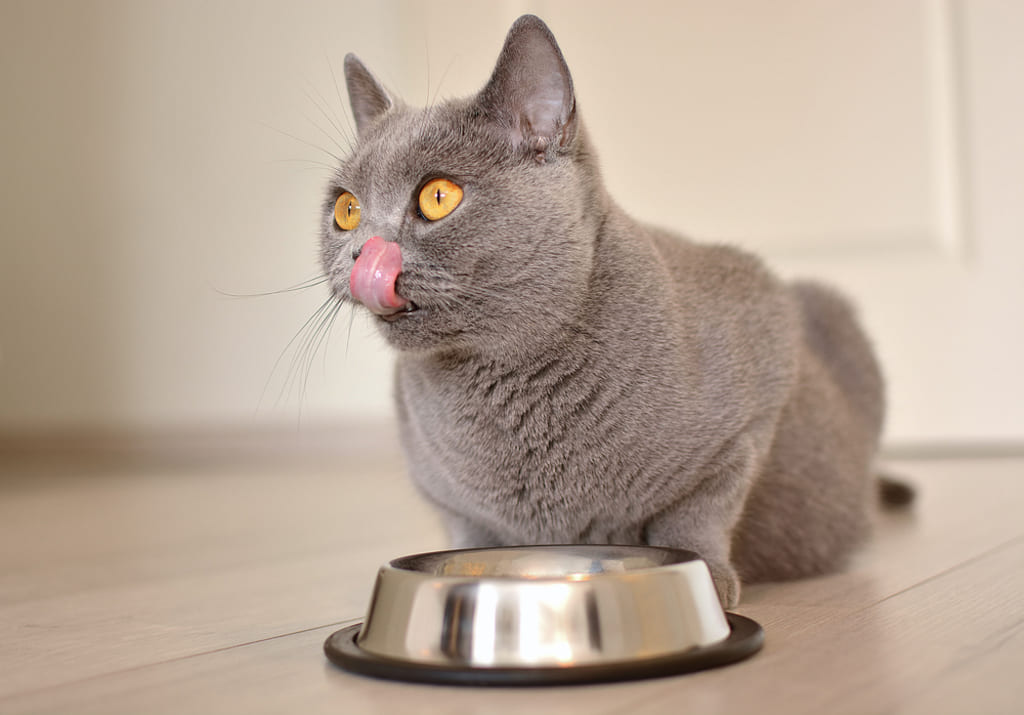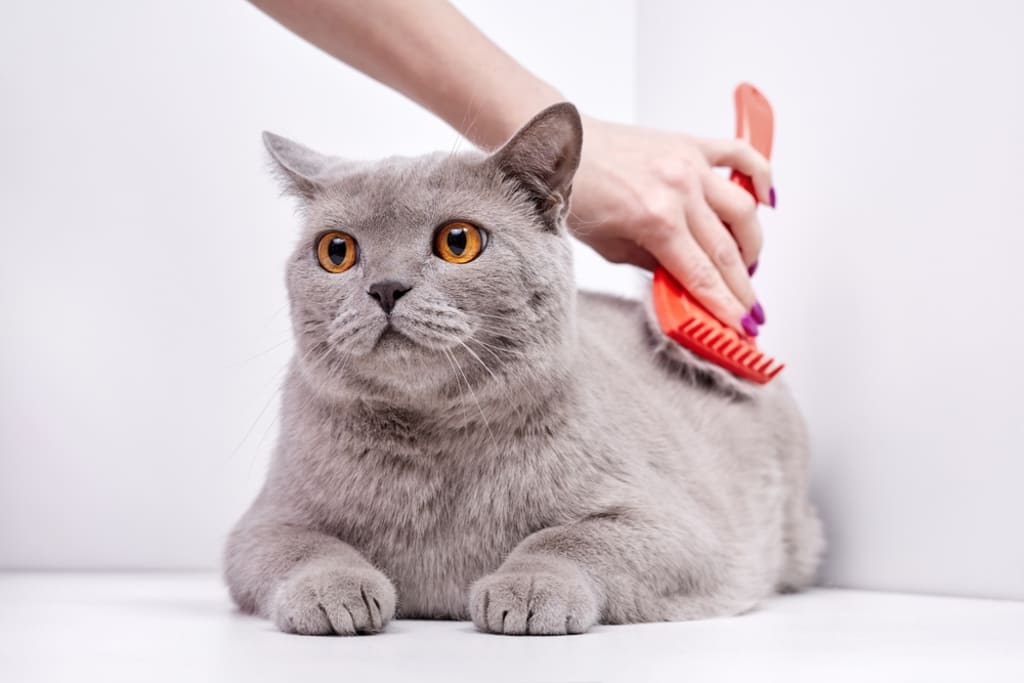Being one of the first recognised cat breeds, the British Shorthair requires no introduction! The British Shorthair, sometimes referred to as the British Blue Cat, is a kind, affectionate, and attention-seeking cat. They have won millions of hearts with their endearing appearance and amiable dispositions. Getting a Blue British shorthair cat is a great option if you’re searching for an active and loving companion! I will cover every aspect of the British Shorthair cat today in this blog. I have attempted to cover all the information you will need to know before purchasing one, from its origin and temperament to its cost and potential health issues. So read through to the end.
British Shorthair Cat Overview
Other name: British Blue
Height: 22 to 25 inches
Weight: 7 to 17 pounds
Lifespan: 12 to 16 years.
Coat: Short and very dense
Coat colors: White, black, blue, red, cream, smoke, silver, golden, tabby, tortoiseshell, and bicolor.
Temperament: Affectionate, easy-going, and gentle.
Needs for Grooming: Medium
Hypoallergenic: No
Origin: United Kingdom
History
- The British shorthair cat is a native of the United Kingdom, as its name implies.
- The fact that this breed has ancient origins is the most surprising thing about it.
- Because of this, the British Shorthair cat breed may be the oldest in the country.
- These gorgeous cats were originally introduced to Britain by the Romans, and they became incredibly well-known in the late 1800s.
- Their unusual blue-gray coat gave them the nickname “British Blue” at first.
- Later breeders crossed British Shorthairs with Persian cats to improve the features.
Fun Fact
British Shorthair cats were one of the breeds that participated in England’s first organized cat show in 1871.
Appearance (Size and Height)
- The British shorthair cat breed ranges in size from medium to large.
- These cats feature a broad chest, round paws, round faces, strong legs, and blunt-tipped tails.
- They also have big, widely spaced ears.
- This breed looks like a fluffy teddy bear because of these traits.
- Given that female British Blues weigh between 6 and 12 pounds and males weigh between 7 and 17 pounds, males appear more prominent than females.
So, how big do British Shorthair cats get?
For your reference, here is the general weight chart for British Shorthairs:
| Cat’s Age | Weight Male | Weight Female |
| 3 Months | 2.1 kg – 4.6 lbs | 1.4 kg – 3 lbs |
| 4 Months | 2.5 kg – 5.5 lbs | 1.9 kg – 4.1 lbs |
| 5 Months | 2.7 kg – 5.9 lbs | 2.3 kg – 5.0 lbs |
| 6 Months | 2.8 kg – 6.1 lbs | 2.5 kg – 5.5 lbs |
| 7 Months | 3.0 kg – 6.9 lbs | 2.6 kg – 5.7 lbs |
| 8 Months | 2.9 kg – 6.4 lbs | 2.7 kg – 5.9 lbs |
| 9 Months | 3.0 kg – 6.6 lbs | 2.8 kg – 6.1 lbs |
| 10 Months | 3.2 kg – 7.0 lbs | 3.0 kg – 6.6 lbs |
| 11 Months | 3.3 kg – 7.2 lbs | 3.1 kg – 6.8 lbs |
| 1 year | 3.5 kg – 7.7 lbs | 3.3 kg – 7.3 lbs |
| 3 years | 4.5 kg – 9.9 lbs | 4.2 kg – 9.2 lbs |
Coat Colors

British shorthair cats have short, thick, and plush coats; initially, they were limited to grayish-blue coloration. But these days, this breed is widely accessible in a range of solid and bi-color shades, such as:
- White
- Black
- Tortoiseshell
- Cream
- Smoke
- Silver
- Calico
- Golden
- Blue
- Red
- Cameo
- Tabby
Characteristics and Temperament
- Playful and energetic cats, British Shorthairs require their owners’ undivided attention all the time.
- Regarding children, the elderly, and other pets, these cats are serene, kind, and loving.
- If you allow them to play with them enough, they will be eternally grateful.
- They make great pets for everyone because of this. Consequently, getting a British Shorthair is easy, regardless of whether you live alone or with a family that includes children and elderly people.
British Shorthair Characteristics
| Affection Level | High |
| Friendliness | Medium |
| Kid-Friendly | High |
| Pet-Friendly | High |
| Exercise Needs | Medium |
| Playfulness | Medium |
| Energy Level | Medium |
| Intelligence | High |
| Tendency to Vocalize | Low |
| Amount of Shedding | Medium |
- Fun Fact
- In 2011, a British Shorthair named Sparky set the Guinness World Record for the loudest purr, reaching an impressive 67.3 decibels, comparable to the sound of a vacuum cleaner.
Health and Nutrition

Although British Shorthairs are a generally healthy breed, they do have a number of health problems, including:
- Hypertrophic Cardiomyopathy (HCM)
- Gingivitis
- Polycystic kidney disease (PKD)
- Feline hypertrophic osteodystrophy (FHO)
- Diabetes
- Obesity
For this reason, routine veterinary exams and checkups are essential to identifying and preventing these ailments. In addition, offering a nutritious diet is essential.
Provide a well-rounded diet that includes all the proteins and nutrients your British shorthair kitten needs to stay healthy. The following vitamins and minerals ought to be included in a healthy diet:
| Vitamins | Minerals |
| Vitamin A | Calcium |
| Vitamin D | Phosphorus |
| Vitamin E | Potassium |
| Vitamin K | Sodium and chloride |
| Thiamin | Magnesium |
| Riboflavin | Iron |
| Pantothenic acid | Copper |
| Niacin | Manganese |
| Pyridoxine | Zinc |
| Folic Acid | Iodine |
| Biotin | Selenium |
| Vitamin B12 | NA |
| Choline | NA |
So, how much should you feed a British Shorthair?
- British Shorthair (Kittens): 3 times a day
- British Shorthair (Adult): 2 times a day
Exercise and Training
- Exercise is a major factor in enhancing the quality of life for British Shorthairs in addition to routine medical examinations.
- These cats are active, but obesity is still a concern for them.
- For this reason, it’s crucial to keep them active with exercises and engaging games.
- Interactive toys, lasers, fluffy balls, fishing wands, and climbing frames like cat trees and shelves are all available for your cat.
- Your British shorthair kitten will stay mentally and physically fit with these activities.
How to train a British Blue cat?
- These cats are intelligent and clever, so they pick things up fast when it comes to training.
- Keep in mind that patience is essential when training these cats. To reward their good behaviour, give them treats and use positive reinforcement techniques.
Grooming Needs

- The benefit of having a British Shorthair cat is that it needs little upkeep and less grooming.
- To get rid of dead hair and skin cells, you must brush their fur several times.
- Incorporate routine dental care and nail trimming into your cat’s grooming regimen.
- Regular veterinary care and grooming services, such as haircuts and ear cleanings, can also be obtained by going to a professional groomer or veterinarian.
Are British Shorthair hypoallergenic?
Cat allergy sufferers are not advised to adopt a British Shorthair cat breed because they are not hypoallergenic.
Price
How much is a British Shorthair cat?
The cost of a purebred British shorthair can run from $1000 to $1500. But keep in mind that these cat breeds can cost up to $3500 because they are pricey. The price is typically influenced by location, breeder reputation, coat colour, and pedigree.
Where can I buy a British Shorthair cat?
Check out your local British Shorthair adoption centres and rescue groups if you’re looking for “British Shorthair for sale” or “British Shorthair kittens for sale.”
Life span
The typical lifespan of a British Shorthair is between 12 and 17 years, but with the right care, frequent veterinary visits, and a loving home, some can even live up to 20 years.
British shorthair for sale
British Shorthair cats are well known for their robust physique and laid-back disposition. These UK-bred cats are well-known for their robust build, which makes them excellent choices for energetic yet kind family pets. The breed is known for its luxurious, thick coats in a variety of hues, the most well-known of which is the “British Blue,” a deep blue-grey coat. However, patterns in cream, black, and white hues are also frequently seen, such as “colorpoint,” “tabby,” and “tortoiseshell.” They are renowned for their submissive, serene disposition, which makes them appropriate for apartments and homes with kids or other pets despite their substantial size. British Shorthairs are known for their independence, low maintenance needs, and healthy balance of socialisation and seclusion.
FAQs
When do British Shorthair cats shed?
For the majority of the year, British Shorthairs shed moderately; however, in the spring and autumn, they shed copiously. Regular brushing and grooming will help to manage this.
What do British Shorthairs eat?
A well-balanced diet containing the right amount of protein, vitamins, and minerals is essential for British Shorthair cats. For advice on the ideal diet for your cat, you can also speak with a veterinarian.
Can British Shorthairs be left alone?
While British shorthairs are generally independent and enjoy their alone time, it is not advisable to leave them alone for extended periods of time. To keep them from getting bored, give them interactive toys, cat trees, and scratching posts.
Get a British Shorthair!
British Shorthairs are wonderful family pets because they are calm, affectionate, and laid back cats. They are easy to train, require little upkeep, and shed moderately. You’ve learned everything there is to know about the British Shorthair cat breed from reading this blog, which will assist you in making your choice.
For more information visit our homepage:

